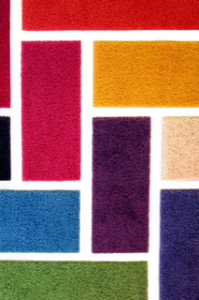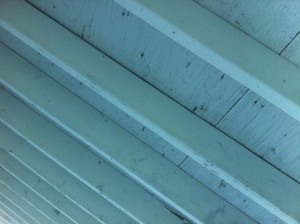Inspiring Interior Design (Part 3)
By Asher Crispe: August 8, 2012: Category Inspirations, Quilt of Translations
Stone Houses
In the previous article, we probed the spiritual function of the Temple in our lives and our lives as a (potential) Temple. Now, we will revisit this phenomenon from a different angle and inquire into the Divine dwelling within the Temple. What houses God? Sometimes alluded to as the “Mikdash Hashem” [Sanctuary of God] as in Exodus 15:17 “…God [Yud-Kai-Vav-Kai] you have made a Sanctuary [Mikdash], God [Adokai] you have established it with Your hands,” the Tetragrammaton, or the name Havayah, is specifically evoked. Why is it this name for the Divine that is housed?
Divine names speak volumes under the microscope of the kabbalists. Many kabbalistic treatises clarify the specialized meaning of specific names which provides us an opportunity for rereading the technical significance of a name back into the scriptural context where it was first encountered. The present example highlights the essential name for the Divine–Havayah (a rearrangement of the letters Yud-Kai-Vav-Kai) that can be rendered as ‘Being’ or ‘Reality.’
Given this information, what does ‘Being’ gain from a Sanctuary which really amounts to nothing more than a house built from stones? The name named tasks us to identify ‘Being’ or ‘Reality’ as dwelling within these stones. It might be said that the stones form a context for Being; they might even allow for the meaning of Being to appear.
Pursuant to this goal, we can unmask another essential symbolic feature within this description by citing the following passage from one of the earliest of all kabbalistic texts, Sefer Yetzirah (4:16):
“Two stones build two houses, three stones build six houses, four stones build twenty-four houses, five stones build one hundred and twenty houses, six stones build seven hundred and twenty houses, seven stones build five thousand and forty houses. From here go and calculate what the mouth cannot express and the ear cannot hear.”
As the myriad of commentators on Sefer Yetzirah point out, a stone represents a letter, a semiotic or semantic building block, a basic unit of meaning or minimally, a component of meaning. Just as stones build houses, letters construct words. Meaning resides within the house; it lives within the words.
Two stones then are like two letters alef and beit (or a and b–any combination of letters will suffice). The total number of permutations of these two letters is two. I can situate them as either a-b or b-a. That’s it. If a third letter/stone should enter in the mix, then I am capable of expanding the number of permutation to six: a-b-c, a-c-b, b-a-c, b-c-a, c-a-b, c-b-a. This passage from Sefer Yetzirah indicates the rapid complexification that occurs as we ratchet up the number of participating letters.
What can we take away from this? Our stone house is really a semiotic structure. As architectural theorist Christopher Alexander puts it in the title of one of his books, we are speaking about A Pattern Language. Building and interior design have a language that is unique to them. Comprehending these linguistic patterns, achieving some fluency in them, has to be earned through the exertion of close readings of the layout and design features of exceptional buildings.
Taking in these relationships, the interpretative leap that equivocates the Temple with prayer–that views the words of prayer as a performance of Temple service in the absence of a physical building–becomes easy. We can even meta-tag these concepts with a striking parallel to a passage in Martin Heidegger’s Letter on Humanism from 1947:
“Language is the house of Being. In its home man dwells. Those who think and those who create with words are the guardians of this home.”
Did we not just establish that the name of God that dwells in the Temple means ‘Being?’ Moreover, we have learned to see the Temple itself through the rubric of language. Fabricated out of stones, the Temple serves as the nexus of semiosis. Taken in this sense, interior design would be tantamount to finding the right words to capture the meaning of Being–that is: to provide a ‘dwelling’ for Havayah. Accordingly, ‘in its home a man dwells’ conveys humanity as a midaber, a speaker. We are with God (who is identified with Being) together within language.
Following up on our previous articles’ Midrashic depiction of the Divine presence dwelling within us, when we become the Sanctuary, we are licensed to try to create with language just as God does (for example in Genesis 1:3 “And God said: Let there be light! and there was light.”) We are charged with the responsibility of being ‘guardians of this home,’ this Temple of language. In doing so, our creativity emulates Divine creativity.
Drawing upon Gaston Bachelard’s The Poetics of Space [p.25] once again, let us consider how:
We are beginning to see what the new model of the home-dweller looks like: ‘a man the interior designer’ is neither an owner nor a mere user–rather, he is an active engineer of atmosphere. Space is at his disposal like a kind of distribution system, and by controlling this space he holds sway over all possible reciprocal relations between the objects therein, and hence over all the roles they are capable of assuming.
Atmospheric conditions are predicated upon our active engagement within the house, with our homemaking aspirations and our harnessing of the raw possibilities of the interior of the building in order to organize them in an intelligible and sensuous way. A stripped down depiction of this process might be described as the unification of person and home. Its an issue of ‘placement.’
This yichud, or mystical unification in Kabbalah, involves the marriage of two channels of Divine emanation of sefirot. The first of these is ascribed the principle role of being a containment vessel or a house. Termed malchut or Kingdom, this sefirah or dimension serves as one’s domain of influence or capacity to effect external reality. We would all like to think that we are the “king” in our own home. We set the rules. We govern. We freely express our will. ‘My’ house is not just a location that is legally recognized as my ‘property.’ In Kabbalah, my home mirrors my ‘properties,’ my soul powers, my personality, my character traits and idiosyncrasies.
The other sefirah or dimension enlisted in the conjunction is tiferet which is one of the most basic words for beauty in the Hebrew language. Specific to this sense of beauty is the idea of variegated experience which is delicately woven together. Tiferet implies synthesis and balance. For both the Divine and human realms, the ordering of the universe–the fine tuning and thoughtful design, the beautification of our world and home–testifies to this ‘humanizing’ faculty.
As one of the most common kabbalistic intentions, a salient verse in Isaiah (44:13) portrays this unification of Tiferet and Malchut as follows:
“…according to the beauty of man, to dwell in the house.”
Man or humanity supplies the beauty (the name Havayah also corresponds to beauty). As the agent of the Divine, the human being is uniquely endowed with the resourcefulness and skill needed to participate in the beatification of the world-home. We mimic the Divine in this respect. Thus, the ‘beauty of man” might be read as ‘the aptitude for making beautiful (humanizing) which wishes to ‘dwell in the house.’
When the entirety of the world shifts from exile to redemption, when the unhomely becomes homely, it will do so because we have achieved a critical level of saturation of Divine consciousness. Global communications coverage binds us together. The wilderness, once tamed, turns from hostility to hospitality. An era when a patchwork of nations–one alien one to the next–collapses into a global village and then–through even more spectacular means of convergence–a giant home, where each is responsible for all the others, then, the sounds of the great Shofar are heard.
The Shofar that heralds the arrival of the Messianic age is not merely a ram’s horn. The sages hint at its true meaning with an expression from the prayers of Rosh Hashanah: “shapru maaseichem” – “improve you actions.” Blowing the Shofar is a call for improvement. The innovation economy and the attending culture of improvement that prevails in much of the world today, elevates the call for positive change to a level never before witnessed in history. Shofar itself means to beautify. This is the ‘great’ Shofar (“great” in the sense of universal). Space-ship earth is the only home we have–a message that should pierce the heart of all of us and inspire humanity to make the most of it.
 An interior design project of such scope and scale requires tremendous leadership. The Torah addresses this by insisting that there is not only a Messianic Age but an actual leadership figure or Moshiach. On the one hand, Moshiach (the Messiah) implies a ‘speaker’ (maisiach) which should trigger associations with the building of the Temple as a model of rectified language (language as the house of Being [Havayah]). On the other hand, we see this redeemer in the role of more than a builder. He must also fill the role of being the ultimate interior designer. The beautification of our outer world reflects the beautification of our inner world. To be at home with our spiritual lives, to be at home with ourselves, entreats us to learn about and practice interior design.
An interior design project of such scope and scale requires tremendous leadership. The Torah addresses this by insisting that there is not only a Messianic Age but an actual leadership figure or Moshiach. On the one hand, Moshiach (the Messiah) implies a ‘speaker’ (maisiach) which should trigger associations with the building of the Temple as a model of rectified language (language as the house of Being [Havayah]). On the other hand, we see this redeemer in the role of more than a builder. He must also fill the role of being the ultimate interior designer. The beautification of our outer world reflects the beautification of our inner world. To be at home with our spiritual lives, to be at home with ourselves, entreats us to learn about and practice interior design.
One of the most ‘beautiful’ allusions to this directive derives from the fact that in Hebrew the word for Moshiach is spelled Mem-Shin-Yud-Chet whose numerical values are 40+300+10+8 or 358 in total. Amazingly, the modern Hebrew expression settled on etzuv pe’nim [עיצוב פנים] for interior design. When we add up the gematria of its letters: Ayin-Yud-Tzadi-Vav-Beit and Pei-Nun-Yud-Mem they are respectively 70+10+90+6+2 and 80+100+10+40 which is also 358
Moshiach = 358 = etzuv pe’nim ‘interior design’.
The entire enterprise of Moshiach is equivalent to an interior design pursuit. Redemption is contingent upon the deployment of the ultimate spiritual interior designer.
In Part Four, we will explore the individual rooms of our ideal home.














;)
;)
;)
;)
;)
;)
;)
;)
;)
;)
